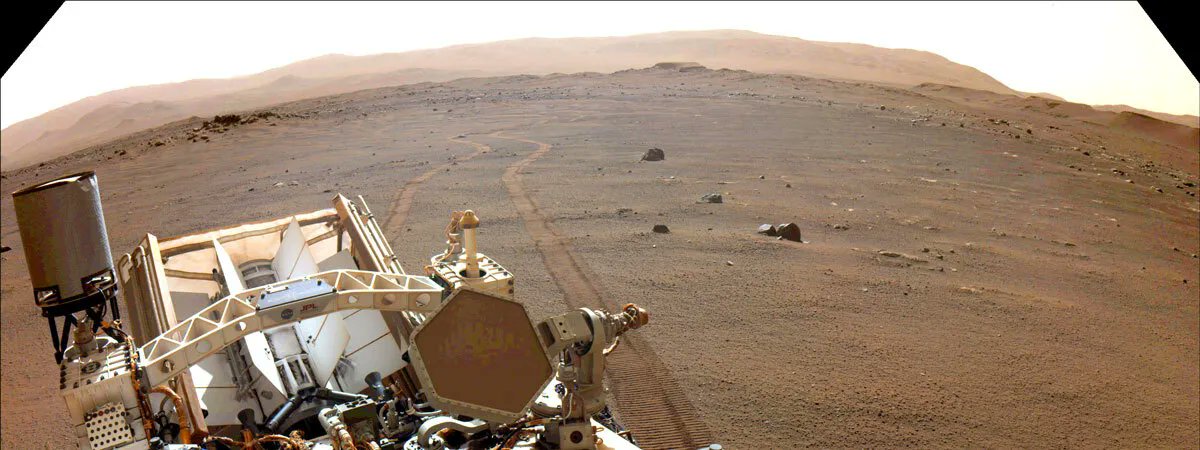Mars rovers are not known for being particularly speedy. Spirit and Opportunity managed a max speed of a whopping 5 cm per second, while Curiosity clocked in at a max speed of .1 kph. Over their long mission times, even those speeds opened up many potential areas to explore. But Perseverance is leaving them in the dust as it makes its way up to a river delta where it will begin its next round of sample collection.
Perseverance began its journey on March 14th and is traveling to a part of Jezero Crater that a river used to flow through. Previously wet sites such as the delta are of particular interest to Perseverance. They would likely be the best place to find any evidence of any ancient (or extant) Martian life. Searching for such evidence is one of the primary mission objectives of the Mars Sample Return (MSR) mission, of which Perseverance is one of the first steps.
MSR will use Perseverance to collect samples on the Martian surface and then send them back via a separate mission with an orbital booster that will take off from the surface of Mars. But to launch those interesting samples into orbit, first Perseverance has to collect them, and in order to collect any exciting samples from the river delta, it has to get there first.
Credit – NASA / JPL-Caltech / MSSS / ASU / University of Arizona
So Perseverance started “hightailing” it, as NASA put it in a recent press release. To do so, it’s relying on a technology that was honed in all the previous Martian rovers before it – AutoNav. This self-driving system is the core of Perseverance’s driving system. While the rover still requires some manual driving intervention from a team of 14 planners who work round the clock to make sure the rover is navigating correctly, AutoNav allows it to navigate over relatively simple terrain much more quickly than previous rover incarnations.
Two major improvements help facilitate that speed increase: better sensors and better self-awareness. Sensors, especially cameras, are a vital component of the AutoNav system. The cameras on Perseverance are so advanced they allow the rover to perform what its navigators call “thinking while driving.” That might sound like a common feature for human drivers (or maybe not in some cases), but for Mars rovers, navigating through the rubble-strewn crater while making navigation decisions in real-time is a significant advance.
That advance is partly due to a dedicated image processing computer based on a field-programmable gate array (FPGA). A dedicated computer for imaging is a major step forward, and the FPGA structure further increases that capability. But even with the best images available, the rover would still be stuck if it didn’t know what terrain it could actually maneuver through.
Credit – NASA JPL YouTube Channel
Self-awareness can help with that, and Perseverance is much better in this department as well. Anyone familiar with the video game concept of a “hitbox” will be familiar with how Martian rovers navigate around obstacles. Curiosity, for example, would avoid any path that was less than 16 m wide. So if two rocks were 15 m apart, the rover would still go around them, despite being able to easily pass through the gap.
Perseverance takes a different approach, with smaller, individual hitboxes for different components of the rover, including its six wheels. With this increased granularity, rover planners can take more calculated risks when approaching obstacles that would have been considered too difficult in the past. Safely making its way over those obstacles will allow Perseverance to continue its sample collection mission much more quickly than its robotic rover counterparts.
Credit – NASA / JPL-Caltech
In that rush, the science team is taking a back seat to get to where they want to go faster. While the rover will be taking tons of images during its travels, it won’t be stopping to pick up any samples along the way, allowing it to get to the more exciting area more quickly. What it will find there is yet to be determined, but the rover’s science team members aren’t the only ones excited to find out.
Learn More:
NASA – NASA’s Perseverance Rover Hightails It to Martian Delta
JPL – NASA’s Self-Driving Perseverance Mars Rover ‘Takes the Wheel’
JPL – NASA’s self-driving Perseverance Mars rover is breaking records
Lead Image:
Perseverance looking back at its tracks in Jezero crater.
Credit – NASA / JPL-Caltech

